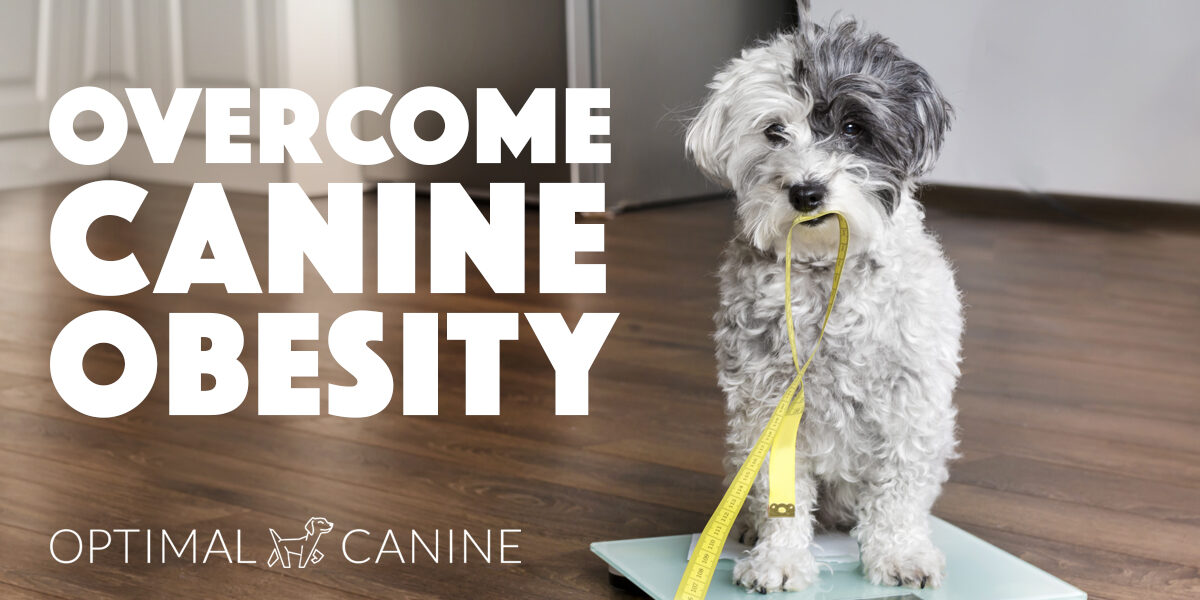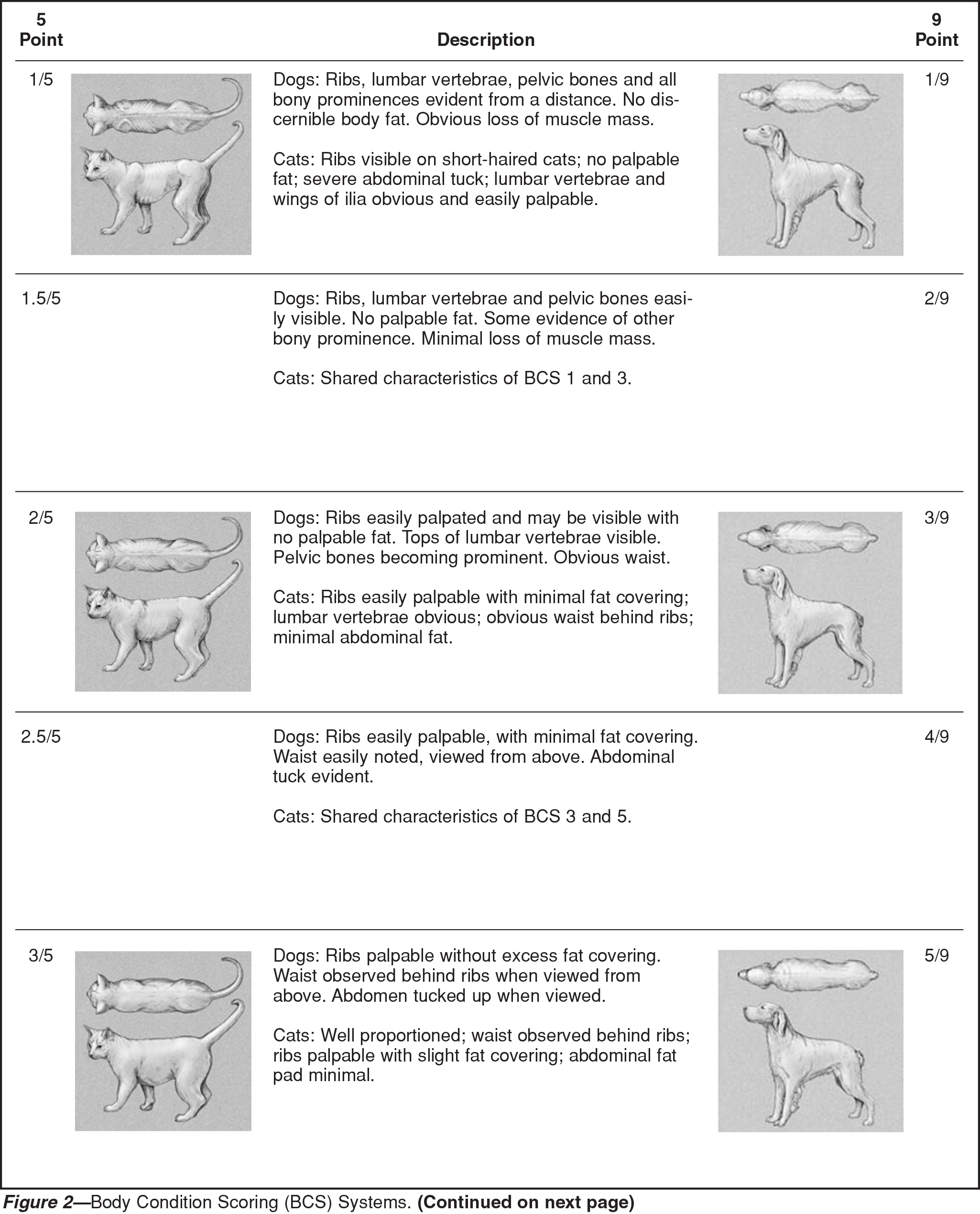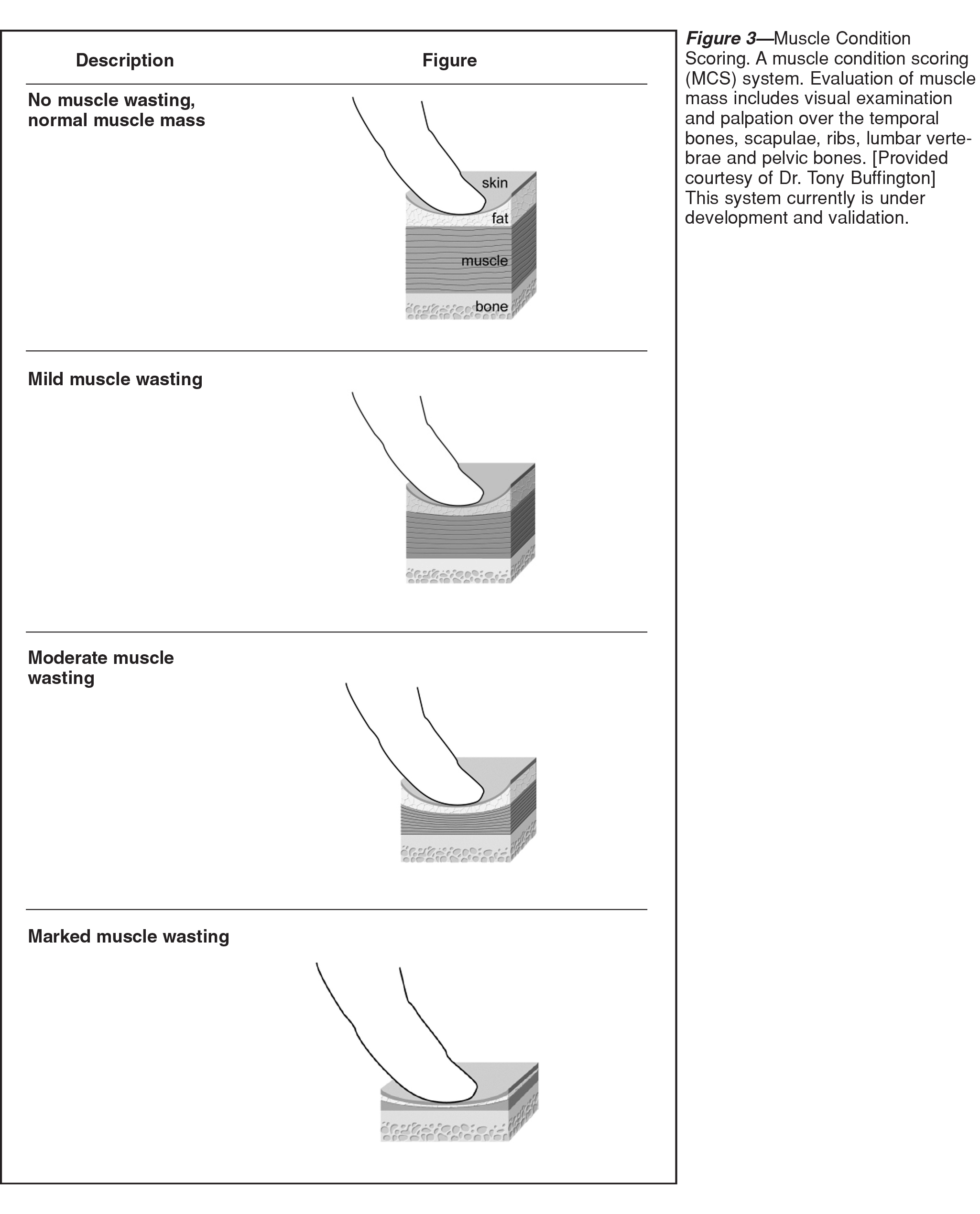Canine obesity is a serious threat to their health. As few as five pounds above a dog’s ideal body weight can risk the development of some serious medical conditions. Unfortunately, when a dog is overweight or obese, it no longer is a question of “if” the dog will develop a condition secondary to the excess weight, but “how many and how soon”.
Identifying if a dog is overweight or obese is dependent on the overall Body Condition Score (BCS) and Muscle Condition Score (MCS).
Body Condition Score (BCS)
The body condition score guide helps evaluate the dog’s body fat and is identified through the evaluation of fat deposits throughout the waist, hips, back, and rib cage. The score is done on a five point scale starting with emaciation (1/5), ideal (3/5), and obese (5/5).
Muscle Condition Score (MCS)
The muscle condition score guide helps evaluate muscle mass and is identified through the physical palpation of the muscles over the face, shoulders, ribs, spine, and hips. The score is done on a four point scale starting with emaciation (1/4), moderate muscle wasting (2/4), mild muscle wasting (3/4), and no muscle wasting (4/4).
BCS is used to identify if the dog is thin, at ideal weight, overweight, or obese, and MCS is used to identify the dog’s muscle amount. The BCS and MCS are not directly related to each other as dogs with a high BCS can have a low MCS. Therefore, it is important to look at both of these condition scores separately when assessing a dog’s physical condition.
According to the Association for Pet Obesity Prevention (APOP) in a 2018 National Pet Obesity Survey, it was reported that 55.8% of dogs in the United States are overweight or obese – this is an estimated 50 million dogs (which is based on 2018 pet population projections provided by the American Pet Products Association)!
Many pet parents are often left feeling overwhelmed on how to appropriately help their dog lose weight. Overcoming canine obesity requires:
Medical & Physical Exam
A complete health exam by a veterinarian is necessary to rule out any medical conditions that could cause weight gain and injuries that could inhibit physical exercise.
Diet Adjustments
A successful weight loss program requires diet adjustments to control calorie intake.
Physical Exercise
Daily exercise is necessary to promote fat burning and weight loss.
These three components are the key to success when creating and implementing a fitness routine for overweight and obese dogs.

Medical & Physical Exam
There are two reasons to have an overweight or obese dog complete a full veterinary exam when beginning a fitness program – to rule out medical conditions, and to clear physical injuries to begin an exercise program.
There are medical conditions that can result in unwanted weight gain and it is important to rule out any potential medical conditions that may be causing obesity. The two main medical conditions that can cause weight gain include:
Hypothyroidism
The thyroid is the main gland and produces hormones that controls the speed of the dog’s metabolism. An under producing thyroid can result in a sluggish metabolism and the dog gains weight very easily. Hypothyroidism can be diagnosed via blood work that tests for Thyroxine (T4) hormone levels.
Cushing's Disease
Cushing’s disease is a disorder that arises from long-term overproduction of glucocorticoid hormones – which are an important aspect of protein, carbohydrate, and metabolic regulation. This overproduction of this hormone is related to abnormal adrenal and pituitary glands. Cushing’s disease can be diagnosed via the Low-Dose Dexamethasone Suppression Test (LDDST).
In addition to ruling out medical conditions, it is important to get vet clearance to begin exercising an overweight or obese dog. Excess weight can cause physical pain and injuries, it is important to rule out any limitations the dog might have, which may include:
Arthritis
Dogs who have additional weight and arthritis are often in pain and should be cleared by a veterinarian before beginning an exercise program.
Joint Dysplasia
There are many types of joint dysplasia conditions that require modifications to exercise programs to prevent the progression of the condition. Hip and elbow dysplasia are two common conditions that require exercise modifications to reduce injury risk.
Ligament Injuries
Ligament injuries, like joint dysplasia conditions, also require modifications and safety precautions to exercise programs to prevent the progression of the injury.
A thorough health and physical examination by a veterinarian is recommended as step one for overcoming canine obesity. The dog can begin a diet and exercise program once the dog is cleared from medical conditions and physical limitations.

Diet Adjustments
The second component of overcoming canine obesity is to evaluate the dog’s present diet and make the necessary adjustments to promote weight loss. It is important to adopt a feeding schedule, portion control, calorie restriction, and low fat diets for overweight and obese dogs.
Feeding Schedule
Adult dogs should be fed 1 to 2 meals a day, whereas puppies should have 2 to 3 meals a day. Free feeding dogs promotes unwanted weight gain and risks canine obesity. All dogs should be placed on a feeding schedule where the dog is fed a set amount of meals each day, but it is very important to avoid free feeding overweight and obese dogs.
Portion Control
Each dog’s diet should have portion control within every meal regardless if the dog consumes a kibble, canned, home cooked, or raw diet. Portion control eliminates the risk of overfeeding which will increase calories and promote weight gain especially in diets for overweight and obese dogs.
Calorie Restriction
Overweight and obese dogs should be fed the amount of calories needed to maintain ideal weight and not the current weight of the dog. The amount of daily calories needed can be compared to the amount of food fed (i.e. meals, training treats, chew treats, and snacks) in one day and adjustments may be necessary to reduce the amount of calories consumed to promote weight loss.
Low-Moderate Fat
All dogs have a nutritional requirement for dietary fat, but overweight and obese dogs needs stategic control over the fat intake in their diet. The bare minimum of fat must be provided for essential nutrients, but an excess of fat will overload calories and reduce the rate of weight loss. Diets lower in fat are ideal for overweight and obese dogs to help promote the burning of body fat.
Controlling the diet is a major component for overcoming canine obesity and should not be overlooked when adopting a fitness program for overweight and obese dogs. Once the dog has achieved ideal body weight and condition, the diet should be adjusted to meet the nutritional needs for daily maintenance without a focus on low fat.

Physical Exercise
The third component of a successful weight loss program for dogs includes physical exercise. Increasing physical exercise increases calorie burning which promotes weight loss in overweight and obese dogs. The exercise program should be strategically created to slowly introduce daily physical exercise, establish a fitness routine, and increase the intensity of the exercises
Introduce Daily Exercise
It is advised to slowly begin an exercise program for an overweight or obese dog, which is to prevent injury as well as condition the dog to like the activity. Injuries can occur if exercise is introduced too fast and the dog will begin to have negative emotions about the exercise if it is too difficult.
Establish A Fitness Routine
Creating a fitness routine is a step to maintaining daily physical activity with overweight and obese dogs. Many dogs enjoy a variety of fitness exercises such as walking, swimming, fetch, and others, and a fitness routine benefits from multiple forms of exercise to keep the dog interested as well as promoting weight loss.
Increase Exercise Intensity
Overweight and obese dogs should not participate in very intense exercises because they risk injury. The intesnsity of physical exercise should gradually be increased as an overweight or obese dog begins to lose weight and gain stamina.
Weight loss increases when a daily fitness program is established. It is recommended to use physical exercise as a major component in a weight loss program, but should be created and executed strategically to prevent injury as well as develop a positive experience.
A Plan For Success
Overcoming canine obesity is not a quick and easy solution. There are various components to successfully overcome canine obesity:
A complete veterinary exam is necessary to rule out medical conditions that could result in weight gain.
A physical exam to rule out pain and injuries.
Diet adjustments to support weight loss.
A fitness program to promote weight loss.
It takes work, time, and patience to help dogs lose weight and achieve physical fitness, but when all the steps are taken and consistently followed, dogs can overcome and prevent obesity!



